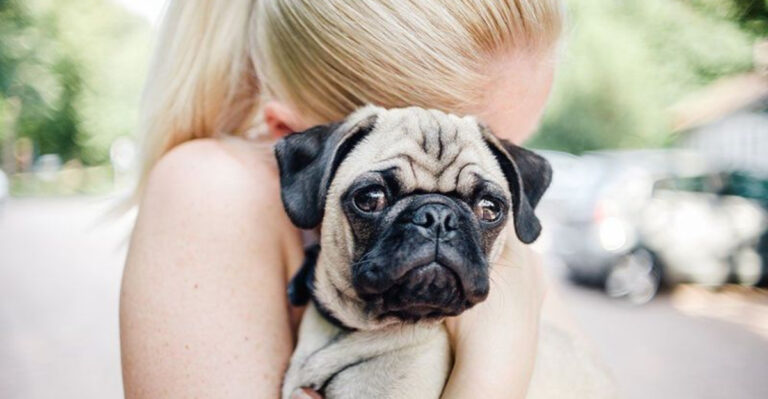15 Common Signs Your Cat Might Have An Upset Stomach
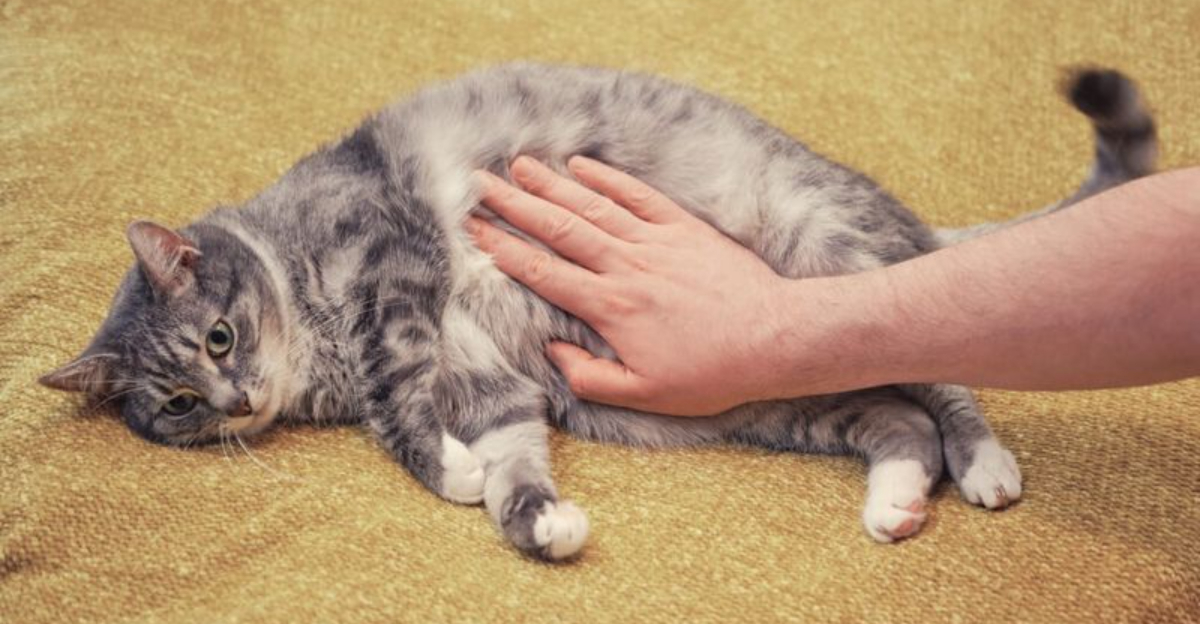
Ever noticed your feline friend acting strangely? Cats are masters at hiding discomfort, but stomach troubles often reveal themselves through subtle behavior changes.
Recognizing these warning signs early can help your kitty feel better faster and potentially prevent more serious health problems. Let’s explore the telltale signals that your cat’s tummy might be troubling them.
1. Frequent Vomiting

Finding hairball-free vomit around the house isn’t normal cat behavior. Occasional vomiting happens, but multiple episodes within 24 hours signals digestive distress.
Vomit containing undigested food, yellow bile, or clear liquid particularly indicates stomach problems. If vomiting persists beyond a day, it’s time for a veterinary check-up.
2. Loss Of Appetite
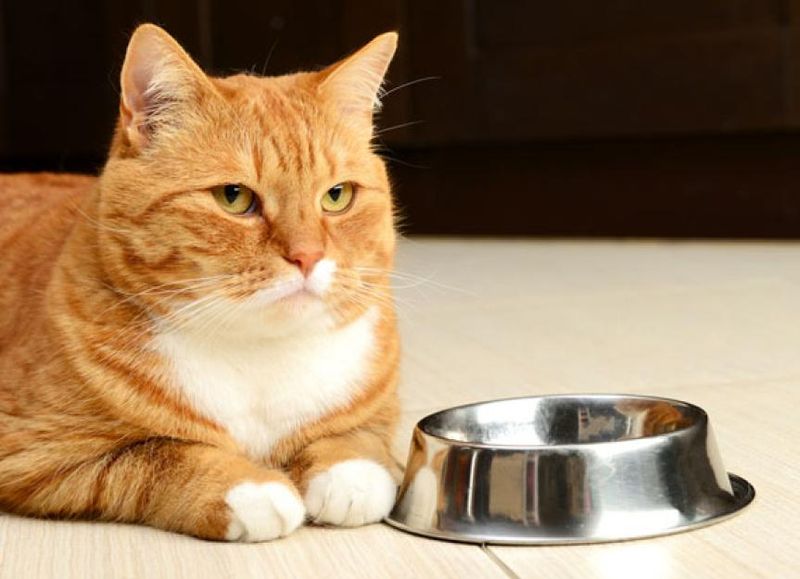
Suddenly snubbing favorite treats raises red flags in the cat world. A healthy cat rarely passes up mealtime, so food refusal often indicates stomach discomfort. Watch if your kitty approaches the bowl, sniffs, then walks away.
This pattern suggests they want to eat but feel too uncomfortable. Missing more than two meals warrants veterinary attention.
3. Unusual Litter Box Habits
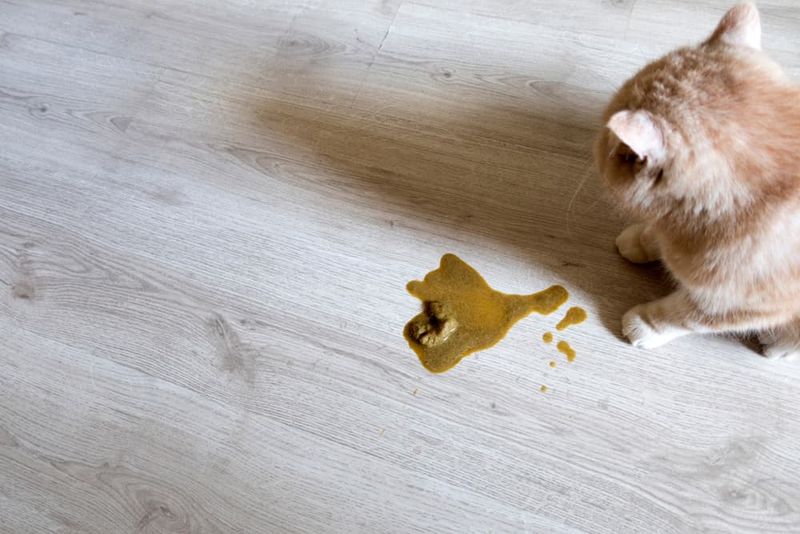
Diarrhea speaks volumes about digestive health. Loose, watery stools or straining without producing much means tummy trouble.
Some cats might even avoid the litter box altogether when experiencing discomfort. Unusual colors like black, very pale, or bloody stool require immediate attention – these could indicate serious conditions requiring prompt veterinary care.
4. Excessive Drooling

Puddles of drool aren’t typical feline behavior unless you’re dealing with certain drool-prone breeds. Unexpected drooling often signals nausea or mouth pain related to digestive issues.
You might notice wet spots where your cat has been resting or saliva hanging from their mouth. This symptom frequently appears shortly before vomiting episodes as your cat’s body prepares to expel stomach contents.
5. Lethargy And Weakness

Your normally playful companion suddenly spending all day under the bed might be nursing stomach pain. Energy levels plummet when cats feel unwell, especially with digestive discomfort.
Look for decreased interest in toys, reluctance to jump or climb, and excessive sleeping. These behavior changes often accompany other digestive symptoms and shouldn’t be ignored, particularly in typically active cats.
6. Excessive Grass Eating
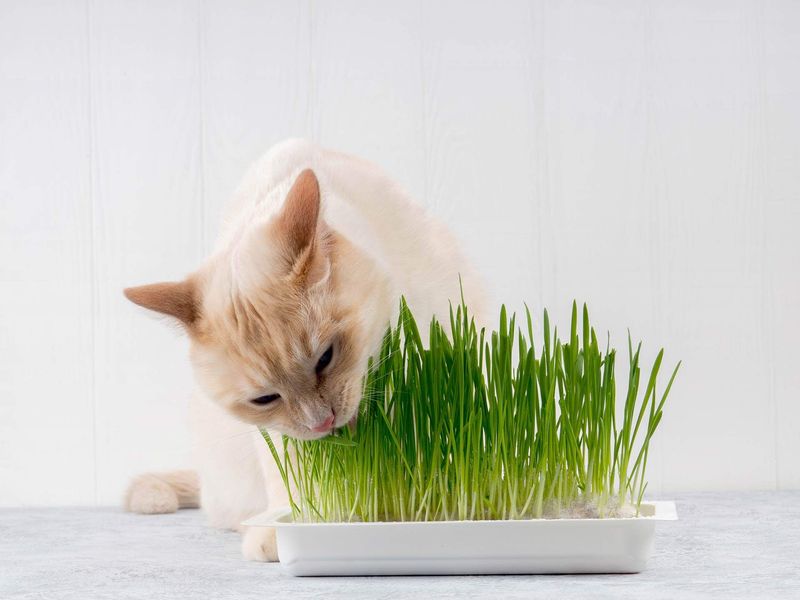
Munching greenery occasionally is normal cat behavior, but suddenly devouring plants like they’re going out of style suggests stomach distress.
Cats instinctively eat grass to induce vomiting when feeling nauseated. Indoor cats without access to grass may chew houseplants instead (beware of toxic varieties!). This self-medicating behavior helps them purge stomach irritants or hairballs causing discomfort.
7. Unusual Body Postures

Hunched positions speak volumes about feline discomfort. A cat with stomach pain often sits with their back arched, abdomen tucked up, or lies in prayer position with rear end elevated.
Watch for frequent position changes as your cat tries to find relief. Some cats press their bellies against cool surfaces like bathroom tiles. These postures indicate abdominal pain requiring veterinary assessment.
8. Gurgling Stomach Sounds
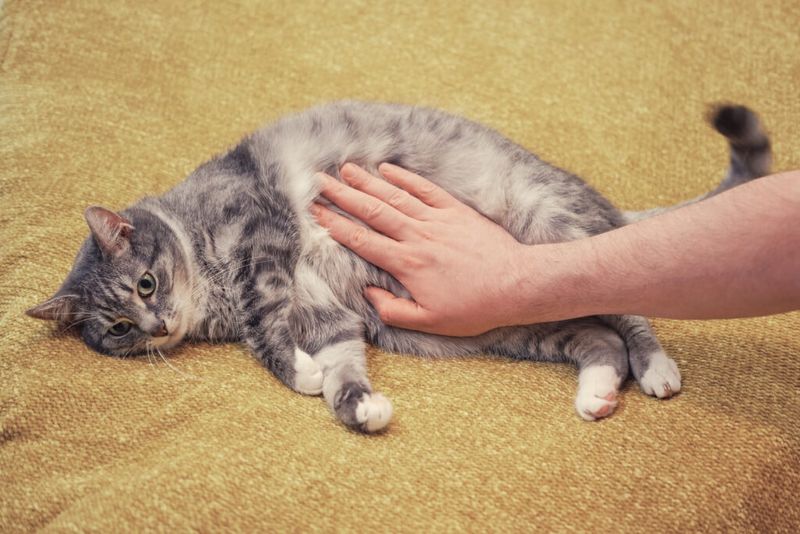
Loud rumbling from your cat’s belly isn’t just amusing – it’s informative. These borborygmi (fancy term for tummy gurgles) indicate gas or fluid movement through the digestive tract.
Occasional quiet sounds are normal, but loud, persistent gurgling suggests inflammation or irritation. Place your ear against your cat’s side near the ribs to hear these digestive symphonies that might signal stomach upset.
9. Excessive Licking Of Lips
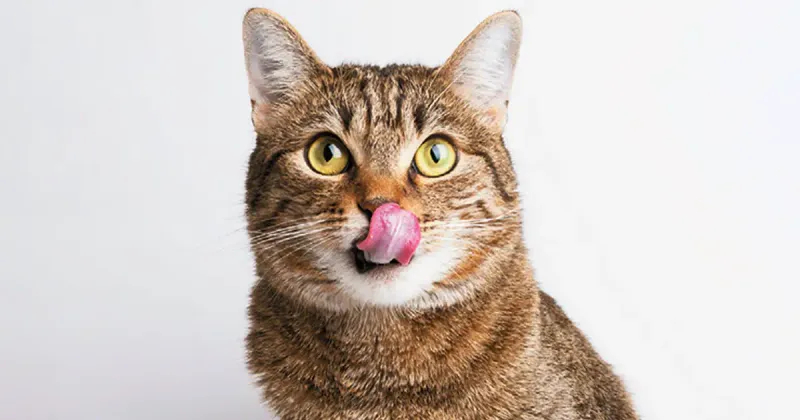
Frequent lip-licking without food nearby signals nausea in the feline world. This behavior helps cats manage excess saliva produced when feeling queasy. You might notice your cat repeatedly sticking out their tongue or making licking motions toward the air. Often accompanied by swallowing or drooling, this subtle sign frequently precedes vomiting episodes by minutes or hours.
10. Increased Water Consumption

Suddenly emptying the water bowl might indicate digestive troubles. Cats with upset stomachs often drink more to replace fluids lost through vomiting or diarrhea. Track water intake by measuring how much you add daily.
Dehydration worsens digestive issues, so while increased drinking shows your cat is compensating appropriately, continued excessive thirst alongside other symptoms warrants veterinary attention.
11. Bloated Appearance

A swollen belly deserves immediate attention. Abdominal distension can indicate serious conditions like obstruction or inflammatory issues affecting the digestive tract.
Gently feel your cat’s abdomen – it should be soft and not painful when touched. Firmness, pain response, or visible bloating requires prompt veterinary care. This symptom can rapidly escalate from uncomfortable to life-threatening.
12. Growling Or Crying
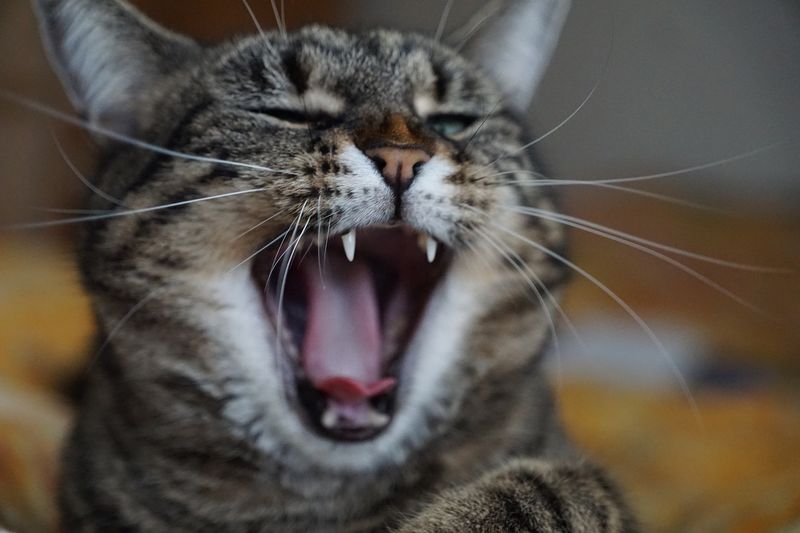
Unusual vocalizations while using the litter box or after meals suggest discomfort. Stomach pain can trigger meowing, growling, or crying sounds cats don’t typically make. Pay attention to timing – sounds during elimination or when the abdomen is touched indicate localized pain. Some cats become vocal before vomiting episodes. These audible clues help pinpoint digestive distress requiring attention.
13. Pawing At The Mouth

Repeated face-pawing suggests your cat feels something isn’t right. This behavior often indicates nausea or oral discomfort related to acid reflux from stomach problems.
Watch for pawing at the mouth followed by excessive swallowing or drooling. Your cat might appear confused by these sensations. This subtle sign frequently goes unnoticed but provides valuable insight into digestive discomfort.
14. Sudden Aggression When Touched
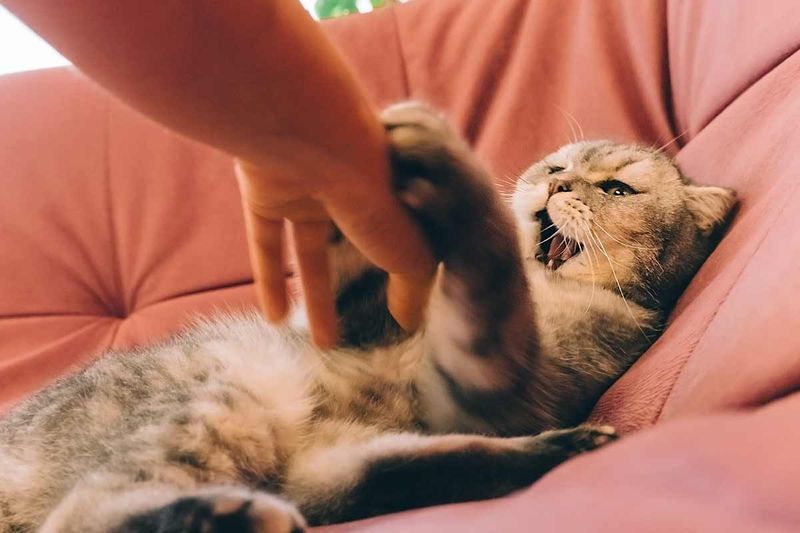
Your normally cuddly companion hissing when you touch their belly suggests pain. Cats instinctively protect painful areas, turning defensive when stomach discomfort makes handling unbearable. This behavior change appears most dramatically in typically affectionate cats.
Try gently touching different body areas to locate pain sources. Abdominal sensitivity specifically points to digestive system problems requiring professional assessment.
15. Weight Loss
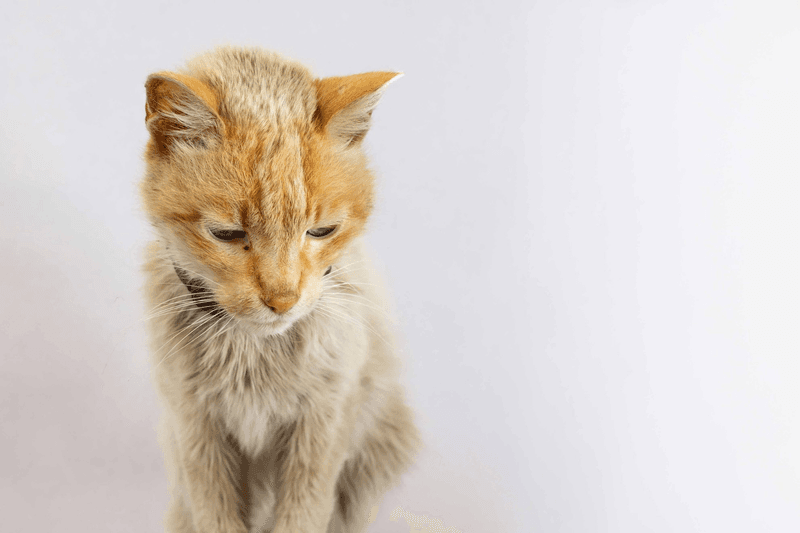
Dropping pounds without trying isn’t a feline diet success story – it’s concerning. Ongoing stomach issues lead to decreased food intake and poor nutrient absorption, resulting in unintended weight loss.
Monitor by feeling your cat’s ribs and spine – they should have light covering without being prominent. Visible weight loss alongside other digestive symptoms indicates chronic issues needing veterinary intervention.


